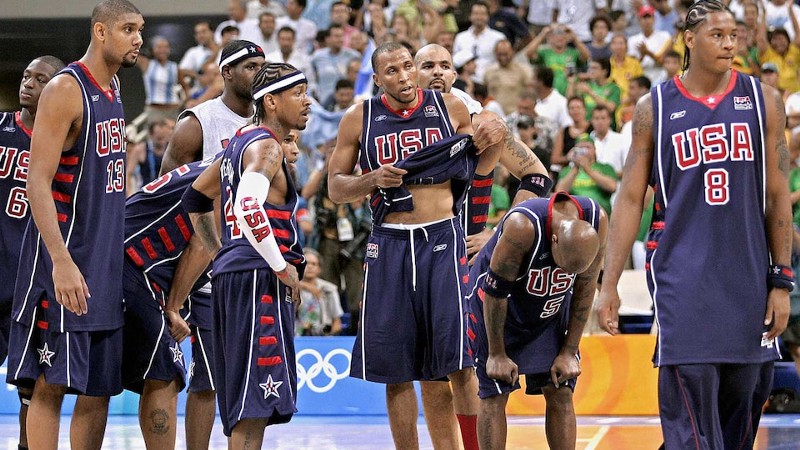Sports Docs We’re Still Waiting For

2004 Men’s US Men’s Basketball Team. Photo courtesy of NBC.
Written By Austin Hall (@ADWAustin)
Documentaries get at the core of why we watch and play sports. Describing sports can lead to using the usual cliches of “guts and blood”, “sweat and tears”, and “all in the name of finding glory.” There is heartbreak and exhilaration, but there are also stories beyond that. There are moments in sports that just don’t happen that often, leading people to ask exactly why and how they did.
Starting in 2011, ESPN created the series 30 for 30, which produced 30 one-hour films from 30 filmmakers in honor of the network’s 30th birthday. The series is still going strong today, and there are plenty of stories to tell. Nowadays, they have added shorts, which are roughly 30 minutes, a feature, which is at least an hour or more, and three- or five-part series that are basically 3 or 5 features on the same topic that air one day after the other. What are some of the biggest stories they have yet to tell? Well, here are a few:
Story: Third Place: The Story of the 2004 Bronze Medal US Men’s Basketball Olympic team:
Category: Feature
Synopsis:
The first (and only) bronze medal for the US since using NBA players, was thanks to a combination of players that had issues with head coach Larry Brown, with a roster constructed out of desperation after many superstars dropped out. As to the reason why, Richard Jefferson and Stephon Marbury both noted that Brown wanted the team to play a certain way, a way in which the players weren’t used to playing. The team lost to Puerto Rico by 19, which starred Carlos Arroyo, a player with an unremarkable NBA career. It was harrowing and a total wake-up call for the US. Players across the pond and in South America were getting better, which was ultimately a good thing for the wealth of NBA talent already in the league (like Manu Ginobili) or yet to come (like Kristaps Porzingis), but was not good for Team USA. They couldn’t just field all-stars and unproven young players anymore. They needed to assemble an actual team. That all changed, of course, but that’s a story for a different day.
Story: A Fallen Icon: The Story of Lance Armstrong
Category: Feature
Synopsis:
He won 7 Tour de France races and overcame testicular cancer, leading to the Livestrong Foundation, launched in 2003 and culminating in a yellow bracelet you could buy to help those affected by cancer. The man was a cultural icon, and millions of Americans loved him, even if they didn’t watch a minute of him riding a bike. He even became Sports Illustrated’s Sportsman of the Year in 2002. However, his fall from grace was sudden and severe, as we all found out that he used steroids. Rumblings that he used performance enhancing drugs began in 2005, and he even admitted as much in 2013 to Oprah, even though he had repeatedly denied the claims for years beforehand. By the time Floyd Landis came around and was doping in 2006 during that year’s Tour de France (he was found guilty in 2007), people in America stopped caring about cycling altogether. Or, in any case, they never cared as much as they did when Armstrong was winning them.
Story: When the Stars Align: NBA Super Teams
Category: Three-part feature
Synopsis:
Many fans say that super teams, built with a bunch of superstars on one team, is ruining the sport. It’s somewhat hard to argue, considering that two of the bigger super teams, the Cleveland Cavaliers and Golden State Warriors, have played each other in the last three NBA Finals.
It all started in 2007; the Boston Celtics needed to add talent around Paul Pierce. They did that by trading for Ray Allen and the 35th pick (Glenn Davis) from the Seattle Supersonics in exchange for Delonte West, Wally Szczerbiak, and the fifth round pick which became Jeff Green. Then, they got Kevin Garnett from the Minnesota Timberwolves in exchange for players on expiring contracts, a bunch of young, unproven players, and future draft picks. That year, they won the 2007–2008 title, then went on multiple playoff runs and another NBA Finals appearance in 2010 that they lost to the Los Angeles Lakers. Once Allen left for the Miami Heat in 2012, it was only a matter of time before they eventually traded Pierce and Garnett to the Brooklyn Nets for a slew of first-round picks and old guys in 2013.
LeBron James is one of the greatest basketball players ever, one of the greatest athletes ever, and certainly the best of his generation. The kid from Akron was drafted by his home team, the Cavaliers, lead them to the NBA Finals four years later, and, after ripping his jersey off because he lost to the Celtics (with Allen, Garnett, and Pierce) in the playoffs again, finally had a decision to make. Does he stay with his team and try to win it for his city? Go to the bright lights of New York or the mystique of Chicago? We would find out, live, on ESPN. On July 8, 2010, in front of millions, and in a matter of seconds, he went from a universally beloved folk hero to a despised villain by joining the Heat with Chris Bosh and Dwyane Wade. At first, they struggled, losing in 2011 in the Finals to the Dallas Mavericks, but the following year, they won their first of two championships in a row (Allen, by the way, helped them win their second). LeBron, ready to change his image back to hometown hero, announced in 2014 that he would be heading back to Cleveland. The Cavs finally won it all in 2016 with a new super team of James, Kevin Love, and Kyrie Irving. That’s part two.
His decision, much like with the Celtics, had a ripple effect, leading to super teams from all over the league. Ironically, the biggest example of this came to fruition more organically than any other. The Warriors, who had won an NBA championship in 2015 and then won a record 73 regular season games the next year all thanks to three superstars that they drafted: Draymond Green, Klay Thompson, and Stephen Curry. Their historic success led to the team getting the second best player in the league, Kevin Durant, and winning the championship easily in 2017. In a vacuum, Durant’s decision makes sense: he probably didn’t join the Celtics because they weren’t going to be good enough to beat the Warriors, and his former team, the Oklahoma City Thunder, had just lost to the team he was joining. When you can’t beat’em, join’em.
The Warriors weren’t the first, and they probably won’t be the last. Superstars like to play with superstars now, it’s just a part of the sport. That’s part three.

Story: The Steroid Era
Category: Five-part feature
Synopsis:
In early the part of the 20th Century, pitchers ruled Major League Baseball, leading to low scoring and what is now known as the Dead Ball Era. They even had a Second Dead Ball Era from the 60s to the early 70s. It is said that performance-enhancing drugs (PEDs) started in the 60s and 70s, and the results were hard to ignore. What was once a game dominated by low scoring, home runs became the norm. Then, in 1994, the season ended unceremoniously due to a strike, putting baseball out of favor with fans. Luckily, in 1998, came the great home run race between Mark McGwire of the St. Louis Cardinals, Sammy Sosa of the Chicago Cubs, and Ken Griffey Jr. of the Seattle Mariners, who fought to break the 61 single season home run record set by former New York Yankee Roger Maris in 1961. While Griffey fell short with 56, McGwire and Sosa both broke the record, with McGwire becoming the new home run king with 70 and Sosa finishing with 66. Three years later, Barry Bonds of the San Francisco Giants broke the record with 73 in 2001. Baseball was back.
But, in 2005, Jose Canseco, a former teammate of McGwire’s back in their days on the Oakland Athletics, published a book detailing widespread steroid use, and named McGwire as one of the perpetrators. Things only snowballed from there. In 2006, the San Francisco Chronicle’s own Mark Fainaru-Wada and Lance Williams wrote a book chronicling, among other things, Bonds and his alleged use of PEDs. Several players testified in front of Congress in 2005, including McGwire, who later admitted to steroid use in 2010. These days, steroid testing, which had already begun in 2003, has become more and more widespread since then.
No matter how you look at it, it’s a black spot on baseball, and sure-fire Hall of Famers like Bonds and McGwire are left out do to their cheating past. The first feature would include the Dead Ball Era leading to PED usage in the 60s, the second could chronicle the 80s and 90s, when players were never tested, the third would detail the ’98 home run race, the fourth would speak on the various books and trials, and the fifth would center on Bonds and the future of testing.
Honorable Mentions:
Preps to Pros: Before the NBA rule that players must be one year out of high school before being drafted, they could be drafted right after high school. To start, there’s a pretty good book on the subject.
Deflategate: After the 2015 AFC Championship Game in the NFL, New England Patriots Quarterback Tom Brady was alleged to have used underinflated footballs. It’s a story that dragged on for years, all because of whether or not a ball was legal to use or not.
Want to keep up with PubSquare Media? Follow us on Facebook, Twitter, and Instagram!



